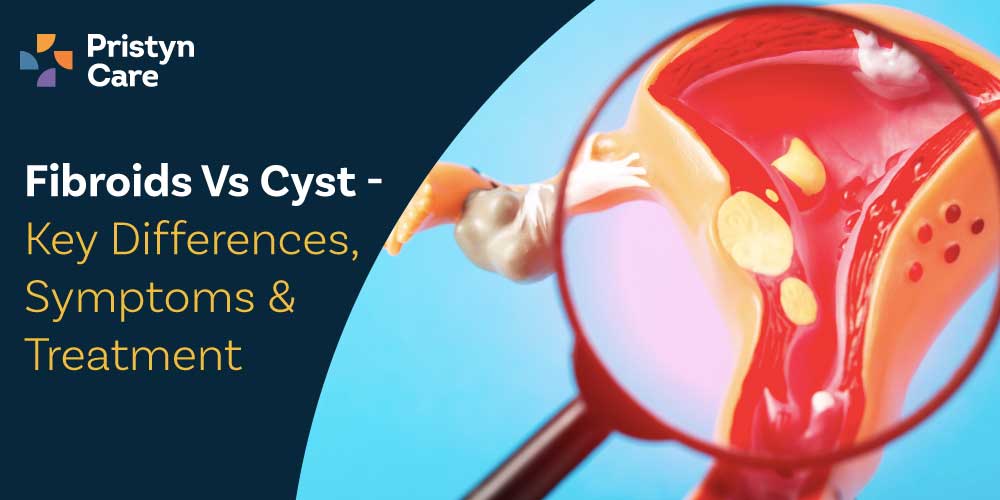
When you hear terms like fibroid or cyst in uterus during a medical check-up, it’s natural to feel anxious. Both can sound alarming and may be linked in your mind to serious illness or infertility. The truth is, fibroids and cysts are two very different conditions – they affect different parts of the reproductive system, have different causes, and require different treatments.
Unfortunately, because their symptoms often overlap, many women confuse them. This can delay proper diagnosis and treatment. In this guide, we’ll walk you through what each condition is, the differences between them, how they’re diagnosed, and the best available treatment options – so you can approach your health with confidence.
What Exactly Are Fibroids?
A fibroid, medically known as uterine fibroid or leiomyoma, is a solid, non-cancerous lump in uterus made of muscle and fibrous tissue. They grow within the wall of the uterus or on its surface. Fibroids can vary dramatically in size, from tiny nodules that are almost invisible on an ultrasound to large growths that distort the shape of the uterus.
Key facts about fibroids:
- They are hormone-sensitive, often growing during reproductive years and shrinking after menopause.
- They can develop in different parts of the uterus – inside the cavity, within the wall, or on the outside surface.
- Most fibroids are benign and do not become cancerous.
- They can be single or multiple.
What Exactly Are Cysts?
A cyst is a fluid-filled sac that can develop in various parts of the reproductive system. The most common type is an ovarian cyst, but cysts can also form in the uterine lining (uterine cysts) or the cervix.
Types of cysts you may hear about:
- Functional ovarian cysts – common and usually harmless, related to the menstrual cycle.
- Endometrial cysts – linked to endometriosis, often filled with old blood (“chocolate cysts”).
- Nabothian cysts – small mucus-filled cysts in the cervix, usually harmless.
Cysts are softer in nature than fibroids because they are filled with fluid rather than solid tissue.
Fibroid vs Cyst – Difference Between Cyst & Fibroid
| Feature | Fibroid | Cyst |
| Nature | Solid muscular growths and fibrous tissues | Fluid-filled sac |
| Location | Uterus wall, cavity, or surface | Ovaries, uterine lining, cervix |
| Texture | Firm | Soft |
| Pattern of growth | Grows gradually over time | Can develop suddenly or gradually |
| Symptoms | Heavy menstrual bleeding, pelvic pressure, urinary/bowel issues | Pelvic pain, bloating, changes in menstrual flow |
| Treatment | Medicines or surgery | May resolve naturally, medicines, or surgery |
Table of Contents
Symptoms of Uterine Fibroids & Cysts – How They Can Overlap and Differ
Fibroid symptoms:
- Heavy or prolonged periods
- Pelvic pressure or fullness
- Frequent urination
- Constipation
- Back or leg pain
- Enlarged abdomen
Cyst symptoms:
- Pelvic pain (especially mid-cycle or before periods)
- Bloating or swelling in the abdomen
- Irregular menstrual cycle
- Sudden, severe pain if cyst ruptures or twists
- Nausea or vomiting (in acute cases)
Because both fibroids and cysts cause pelvic pain, swelling, and menstrual changes, only a medical evaluation confirms the diagnosis.
Causes and Risk Factors
Fibroids often develop due to:
- Hormonal factors (estrogen and progesterone)
- Family history of fibroids
- Early menstruation onset
- Obesity or high BMI
Cysts form due to:
- Natural ovulatory cycles
- Hormonal disorders (e.g., PCOS)
- Endometriosis
- Pelvic infections or prior surgeries
Special Cases of Cyst in Uterus & Ovarian Fibroids
Uterine cysts
A uterine cyst is less common than an ovarian cyst but can cause symptoms like abnormal bleeding, pelvic pain, or infertility. Sometimes described as water bubbles in uterus symptoms, these may be fluid-filled pockets in the uterine lining. Most are benign, but some require removal if they cause symptoms or grow in size.
Ovarian Fibroids
The term “ovarian fibroid” is technically incorrect. Fibroids originate from the uterus, not the ovaries. If a growth is in or on the ovary, it is likely a cyst or, in rare cases, another type of tumor. This confusion often comes from ultrasound reports where the fibroid is located close to an ovary.
How Are Fibroids and Cysts Diagnosed?
When you consult a gynecologist with symptoms like pelvic pain, irregular bleeding, or a noticeable lump, the first step is to confirm it’s a fibroid, cyst, or another condition. Your doctor may recommend the following diagnostic tests for fibroids and cysts:
- Pelvic examination: The doctor gently presses on your lower abdomen to check for any abnormal masses, enlargement of the uterus, or tenderness that might indicate fibroids or large cysts.
- Ultrasound (Transabdominal or Transvaginal): Make use of sound waves to create real-time images of the uterus and ovaries. This determines the size, location, and type of abnormal growth present.
- MRI (Magnetic Resonance Imaging): Gives highly detailed images of the pelvic organs, useful in mapping fibroids before surgery or differentiating between different types of cysts.
- Blood tests: Hormonal panels identify hormone-related growths, while specific markers like CA-125 may be checked if there’s a possibility of ovarian cancer risk.
- Hysteroscopy or Laparoscopy: Minimally invasive procedures where a thin camera is inserted through the vagina (hysteroscopy) or through small abdominal incisions (laparoscopy) to directly view the uterus, ovaries, and surrounding pelvic structures.
Treatment Options for Fibroids & Cysts
When it comes to fibroids and cysts, there is no one-size-fits-all treatment. The right approach depends on your age, the size and number of growths, the severity of your symptoms, and your plans for future pregnancy. Here’s a closer look at how each is managed:
Uterine Fibroid Treatment
Medicines – Doctors may prescribe hormonal therapy, such as gonadotropin-releasing hormone (GnRH) agonists or birth control pills, to help shrink fibroids and control heavy bleeding. While these medicines can provide relief, their effects are usually temporary and symptoms may return once the medication is stopped.
Minimally invasive surgery –
- Hysteroscopic myomectomy is performed through the vagina and cervix to remove fibroids that grow inside the uterine cavity.
- Laparoscopic myomectomy uses small abdominal incisions to remove fibroids from the muscular wall or outer surface of the uterus. This approach preserves the uterus and is often preferred for women who wish to maintain fertility.
- Hysterectomy involves removing the uterus entirely and is generally recommended for women with very large fibroids, multiple growths, or severe symptoms that do not respond to other treatments. It is a permanent solution but also means you will no longer be able to get pregnant.
Cyst Treatment
- Observation – Many small ovarian cysts, especially functional cysts related to the menstrual cycle, often resolve naturally within a few weeks or months. Your doctor may recommend regular ultrasound scans to monitor changes in size.
- Hormonal treatment – Birth control pills or other hormonal medications can help regulate ovulation and reduce the formation of new cysts. In some cases, they may also help existing cysts shrink.
- Laparoscopic cyst removal (cystectomy) – If a cyst is large, persistent, painful, or suspected to be abnormal, your doctor may recommend removing it surgically. The laparoscopic approach involves small incisions and a quick recovery, with the aim of preserving as much healthy ovarian tissue as possible.
When to Immediately Seek Medical Attention
Call your doctor immediately if you have:
- Sudden, intense pelvic pain
- Heavy menstrual bleeding with clots
- Severe bloating or rapid abdominal enlargement
- Fever with pelvic pain
- Fainting, dizziness, or rapid heartbeat
Expert Care for Fibroids and Cysts at Pristyn Care
At Pristyn Care, you get advanced and personalised treatment for both fibroids and cysts. With us, you receive holistic healthcare services
- Experienced gynecologists and laparoscopic surgeons
- State-of-the-art diagnostic and surgical facilities
- Minimally invasive procedures for quicker recovery
- Free pick-up and drop on the day of surgery
- Insurance and No-Cost EMI assistance
- Free post-surgery follow-up consultations
Don’t neglect symptoms like abnormal bleeding, pelvic pain, or bloating. Timely medical care can save you from unforeseen complications and improve your quality of life. Call us today at Pristyn Care to book your consultation and get a complete treatment plan customized as per your needs.







